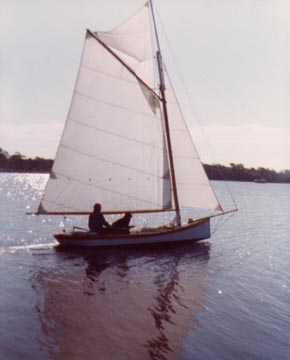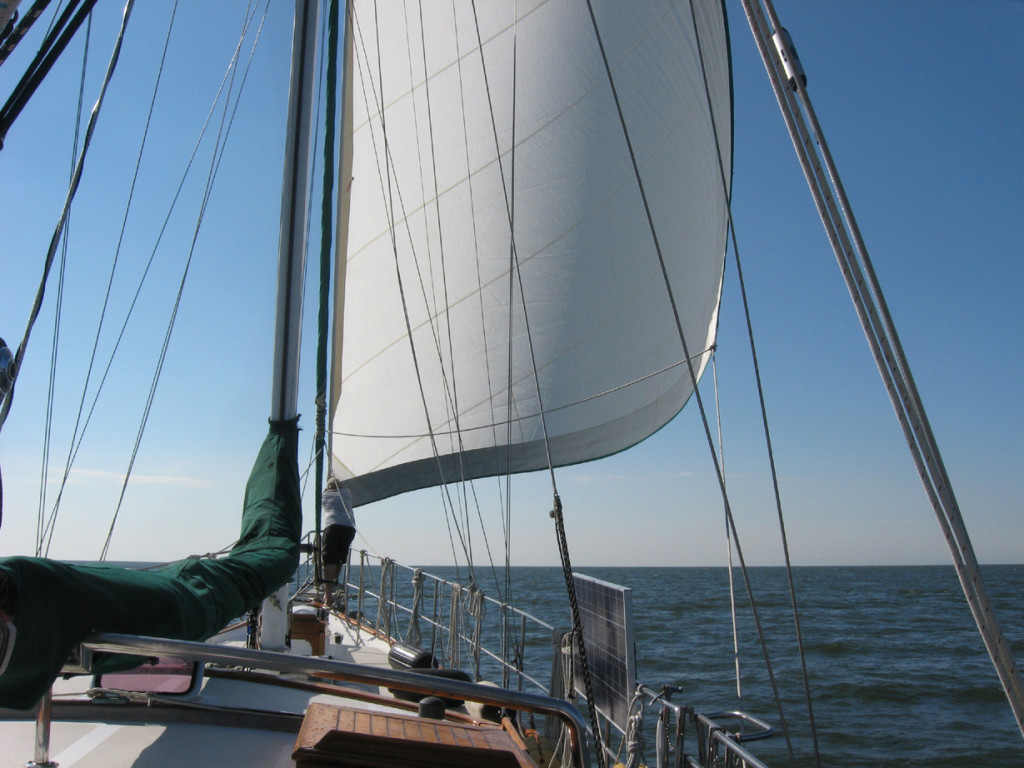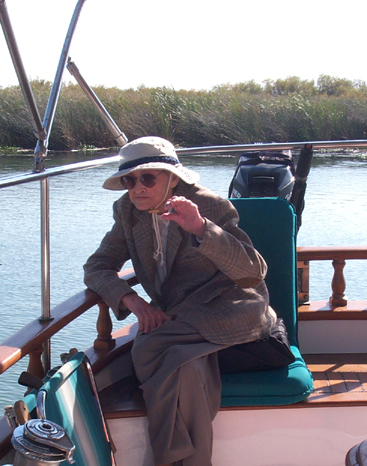Sara Meadows 1914 – 2004
I first loved sailing because of her. She was my aunt, fourteen years my mother’s senior, named Sara, called Sister by all of us and Tadie by the town she knew, a Southern thing. I remember the way she wore her boat cap pulled low, the sleeves of her loose shirt rolled above the elbow as she tacked past crab pots and out the narrow channel from Sleepy Creek into Core Sound.
Granddaddy, a North Carolina shipyard owner in pre-Depression days, presented Sister with her first sailboat when she was nine, pushed her off and let her learn. He made sure his kids and grandkids loved the water and the fruit that came from it. I can picture him, standing in his suit, his hat straight on his head, shucking oysters.
Granddaddy once owned a big, old white trawler. The Albatross convinced a very young me that engines stank, screamed, and usually quit just when you needed them to go. In contrast, Sister’s sailboats smelled of salt and water, sounded of wood pounding against waves or slushing through them, of sails flapping through a tack, of spray spitting as it doused us. Sometimes we heard only the water lap against the hull, the air a mere breath. Sailing, we never missed the gulls’ screech or the dolphins’ leap. The family divided into sailors and stink potters and met as a fleet for lunch outings at Cape Lookout.
Granddaddy sent my brother Dick and me to a boating camp to learn to sail or to mess around in motorboats. Sister called me a natural born sailor, and I wanted to prove her right, so I returned a second year. I hadn’t told her about my initial crewing experience aboard a Sunfish during the first year at camp. The Sunfish’s skipper, an older girl of 12, ordered me to hang on to the line attached to the sail. The wind filled the sail, and over we went. When we’d righted the boat and clambered back aboard, she repeated, “Hold on!” Ever faithful, I clutched that rope. Before we went over for the third time, a counselor motored near enough to yell, “Ease the sheet! The line in your hand!” Aha! Motivated the second year, I raced Sunfish and won, led flotillas across the Neuse, and qualified to sail the larger Lightnings.
In the days when Joan Baez and Bob Dylan defined our adolescence, Dick and I sailed the Potomac on the Sunfish we bought with our lawn mowing/babysitting-for-50-cents-an-hour cache. She was a beautiful, sleek thing with green combing and a striped sail. Dick liked the wild winds; I preferred calmer seas when the only thing I had to fear was a dying wind and the giant Mount Vernon Line plowing up the middle of the channel. Twice, a friend and I took turns paddling madly toward shore.
In my thirties, I huddled with my children around a wood stove in our leaky old house on Maryland’s Eastern Shore, espousing self-sufficiency while secretly craving central heat. In those days, I sailed during weekend visits to Hooper’s Island, now home to the Sunfish, and on summer trips to our North Carolina base. The Sunfish took me out on the Honga River and through the bridge to Tar Bay, exploring, racing the sedate crew aboard my step-father Peter’s small sloop, Turtle. Back in North Carolina, Sister commissioned a Marshallberg yard to construct a wooden sharpie, Puff, a narrower boat than her last, gaff rigged and shallow bottomed. The fleet continued to grow when Peter and my mother brought down a larger boat, a centerboarder with a flip-up rudder that could handle the shoal waters of coastal Carolina. Magnolia Blossom, so named because that’s what Peter often called my mother, had room to sleep aboard, but she was a heavy girl, badly balanced, and fought when we’d run before a storm. Mother sold her after Peter died.
Puff, instead, is “yar,” as Cary Grant would say. She slips over the water in barely any wind and draws so little that we can take her deep into marshy canals. Her brightwork whines when I neglect it, and she’s temperamental in gusts, but she dances with dolphins and slips blithely over shoals. The last time Sister sailed Puff, she was too old to have ventured forth with only my mother as crew, and she ran Puff aground, snapping the mast and splitting the bowsprit. Puff’s builder, Gary Davis, repaired her heavy wooden spar, changed her from gaff to marconi rig, and shortened the bowsprit.

Sister lived with me for the last nine-plus years of her life, which was only fitting, two sailors in love with the same boat. We divided our time between Delaware and Sleepy Creek for seven of those years, and then our life changed. With Puff and the Sunfish spending winters in the Sleepy Creek boat barn, Sister and I embarked on a new adventure, flying back and forth across the country between our North Carolina home and the California house that welcomed us when I married Michael.
A man can only sail one boat at a time, so Michael, who’d learned on Luder 44′s in Pensacola, left his 25-foot Coronado at the dock while he escaped land in his Clipper Marine 30. Sailing the San Juaquin River, he dreamed of more. I, on the East Coast, imagined more. Enter the internet and its ability to match key words like “tall” and “sailor.” We met and married, and now there is more.
Coastal sailors, we dreamed of heading to sea. Stacks of sailing magazines fill the corners of both homes. Books by adventurers like Joshua Slocum and Tania Aebi line our bookshelves. How could we follow in their footsteps? Children in college or at home, little in savings because of past medical issues from a dying wife. And we had Sister, who, approaching 90, was weak, often mind-bound, yet eager for adventure. Michael and I sent up a prayer and believed that if we were supposed to go, we’d find a boat and find a way.
A simple Mother Earth-y boat, we said, and then remembered all those responsibilities. My life with Sister was a wither I goest, she cometh. Could she go to sea with us? Would she be happy? We got our answer one day when Michael carried her onto the Clipper Marine, and we set sail. A smile spread, and we watched peace drape her shrunken form. We knew we were seeing something wonderful when she asked if she should move to the high side after we tacked. She may not have remembered the last five minutes, but she remembered sailing and what one did in a small boat. She couldn’t be left behind. Whatever boat we bought would have to accommodate Sister. Michael knew he could engineer something to help her board and move around. Did she want to go? “It would be a whole new life,” she said, sighing wistfully. Sail somewhere exotic? Please, yes.
We have four children who may want to meet us in some fascinating port. And soon, perhaps, grandchildren. My mother loves to snorkel and sail. We needed room for these. I write, after years of doing portrait sculpture, and didn’t want to be stuck in some dark corner. The yards of window overlooking the water at Sleepy Creek had spoiled me. I wanted to be able to sit at my keyboard and see out boat windows, wherever out happened to be. And Sister’s vision impairment made light an imperative. A reader and a tinkerer, Michael would be happy in whatever space would work for me.
We wanted a sea worthy boat, whatever that meant. I imagined a boat that pointed well, that listened to my nudges. Then I read about righting moment and keel bolts and belly-upping, and I thought, maybe our new home didn’t have to go to weather as well as Puff does. Maybe she just had to be safe. My racing-sailor cousin reminded me that, “Gentlemen never go to weather.” How, I wondered, do they manage that? Engines, Michael said. Pooh, said I.
A boat that would be our home also had to be beautiful. To us that meant a lot of wood. I know, I know. We’ve enough to do maintaining Puff. But we can’t help it. Years of reading Wooden Boat, of watching my father (who caressed the mahogany on his cruiser and taught me much about beauty), and there you are. As a sculptor, I’m tactile and visual. The boat’s lines would have to please my eye, and my hand would want to slither along polished wood. A sensual thing, agreed Michael.
So, where were we? We’d decided on three cabins–Sister, a kid or two or my mother, and us–along with a pilothouse for light. Three cabins meant a lot of boat. Yikes. We were small boat sailors. Not rich. We couldn’t go out and order up a new boat, not even a cheap new boat.
We started looking. Hundreds, thousands of boats showed up on the internet, in the local magazines, at docks. We hoped to squish into 42, maybe 45 feet. I began looking on the East Coast, Michael on the West. I saw my first pilothouse in Annapolis, an old girl in need of work. She seemed huge on deck, but too small down below. I dreamt of ways we might improvise. After all, she was designed by Ted Brewer, a man whose writing first made me think about boat design as a functional matter. I listened to brokers rave about one type or another, whatever they were selling. I worried that our needs wouldn’t fit into our upper size limit. Maybe my perspective was as much a function of my height and my personality as of my circumstances. I am 5’11″ and like space and privacy. The entire horizon would be mine when on deck. Inside, I didn’t want to huddle.
Michael insisted I didn’t need to be afraid of big. Boats are like planes, he said. Moving from a small jet fighter to a huge cargo plane merely meant adjusting his mental image to visualize the larger space. I worried about hard things like docks if I were at the helm. I wasn’t afraid to sail a large boat, merely to pilot her into a small space with something unmovable in the way. We couldn’t fend off twenty tons. He promised to give me lessons with buoys in open water and reminded me that we would have an engine. I had never skippered a boat with anything more than an outboard off the back. But I had forgotten, for a moment, that Michael’s engineering bent is mechanical, that he loves engines and gadgets and computers, a trait quite fascinating to someone like me. A man who can make things work.
Michael took my son Joshua camping along the California coast to show him the Left Coast and its majestic cliffs, soaring trees. Joshua begged to see surfers, the scantily clad, female ones. After all, he was nineteen and his hormones raged. They compromised. Joshua could ogle surfers if he would agree to a small detour to visit a boat for sale by owner in Long Beach.
It was a Formosa 51, a twenty-five-year-old fiberglass, William Garden-designed pilothouse. Muscle-bound Joshua couldn’t believe the deck didn’t rock when he jumped on board. This was no Puff. He and Michael both liked the head room, the space inside. Michael began to think 50 feet was about right, but this boat had a deep keel. Eight feet of draft might work fine on the West Coast, but she’d never be able to anchor off Beaufort or make it up the Neuse River.
We started calling brokers who listed big boats. We liked William Garden’s designs, the clipper bows, the sweeping decks, his use of wood. I have an old book of Sister’s, full of his drawings. Another inherited taste? We found a Hudson Force 50 that was immaculate, which meant way too expensive. We began to think old, needing work, but just a little bit, please. I chatted with owners who loved their Force 50, who said their boat was a dream to live aboard, who said she tracked impeccably. They also said the Force 50 was slow, but slow was no issue. We don’t sail to get there quickly. We sail to sail. We continued to dream.
And then, on the nternet, we found a Force 50 for sale down in Mexico. Michael flew to meet the owner. These old boats have a reputation for leaky teak decks. The owner said he had already removed the teak and replaced rotten wood. Plus, the price was right. The surveyor gave us a thumbs up, and we signed on the dotted line.
On our sailing website, you can read about the unexpected problems we found hidden behind all those pretty words, the fact that the little bit of work turned into a huge project. Once we were able to bring Sea Venture to California, we began taking Sister on board with us. She loved the cockpit, sitting out of the sun under the bimini. She loved anchoring out and eating a meal off a tray. We bought folding steps with a handrail so she could board easily, and Michael first used the bosun’s chair to lower her through the butterfly hatch into the salon. There she would nap while we worked.

She used to touch the lovely wood on Sea Venture, look back over her shoulder as I wheeled her down the dock, gaze happily at the boat’s long, sleek lines, and say, “This is our boat? She’s so beautiful.”
Sister Sara died peacefully at our home in Sleepy Creek the day before Thanksgiving, 2004. Ten days earlier she’d climbed up Sea Venture’s stairway for the last time to have lunch with Dick and his wife Linda who had come down from Napa for the afternoon. Because the day was too cool to sit in the cockpit, Michael and Dick lowered Sister into the pilothouse, where Linda spread a feast before us. Sister devoured hers, concentrating heavily on the raspberry cookies.
Sister may not have sailed to Tahiti with us, but she did get to dream, and to plot, and to plan with us. I imagine her now, watching from above, delighting in the progress of “her” boat–because it is hers, in so many ways–and knowing that we remember her, that we honor her, that we’re both grateful to have had her in our life.
Now it’s just the two of us in a boat built for more. But who knows? God may bring our family or friends to share the adventure, sailing wherever His Spirit takes us.
